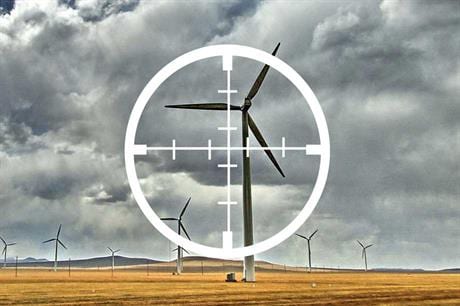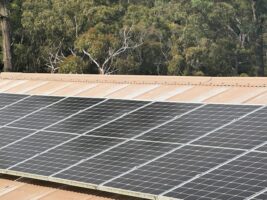The Coalition attacks against renewable energy in the last few weeks have reached their highest peak since the early days of the Abbott government, when the former prime minister hired a climate denying corporate leader to “review” the renewable energy target and try to have it scrapped.
It managed “only” to reduce the target by around a third, but the uncertainty it created still succeeded in bringing the industry to a halt: so much so that since Abbott’s election in September 2013, only one large-scale project has escaped the snare – the 175MW White Rock wind farm that is being built by the deep-pocketed Chinese turbine manufacturer Goldwind.

All other projects that have been, or are being built, with finance or grants from institutions that the Coalition has spent much of the past three years trying to dismantle, such as the Australian Renewable Energy Agency, or thanks to state-and territory-based targets (such as the ACT’s) that the federal government is now trying to destroy.
The new campaign against state-based renewable energy targets – and the deployment of its most potent weapon, policy uncertainty – has reached a new intensity since the blackout in South Australia and the release of an independent report into Queensland’s 50 per cent renewable energy target for 2030.
The Murdoch media have dutifully switched into relentless attack mode. The Courier-Mail ran three opinion pieces demonising the renewable target over the weekend, and The Advertiser in Adelaide and other Murdoch media have been full of anti-renewable commentary. The Australian mothership has followed suit, quoting the usual assortment of vested interests and Coalition politicians about what a disaster high levels of renewables would be.
Chief among them is energy and environment minister Josh Frydenberg, who told The Australian there was an “increased chance of blackouts” if the states did not “harmonise” their renewable energy targets – i.e. abandon them and conform to the national target, which expires in a little over three years.
Indeed, Coalition politicians at state and federal level have been in lockstep with vested fossil fuel interests in pushing the line of “reliability and affordability”, despite a Queensland panel’s own findings that the state’s target would actually reduce costs to consumers and would not impact on system security.
Stanwell Corp, the state-owned company that owns coal- and gas-fired generators, blamed renewable energy for shifting Australia from one of the lowest-cost electricity countries to one of the highest.
That’s not the fault of renewables, though, it is the result of a more than doubling in wholesale prices driven largely by the energy oligopolies, huge but avoidable network investments, soaring gas costs, and the bidding patterns of companies such as Stanwell.
Stanwell was joined in The Australian‘s front page story by the usual suspects – former Labor treasurer and coal company chairman Keith de Lacy, who repeated his oft-spoken line that renewables would be the “end of manufacturing” in Australia, and former Business Council of Australia president Graham Bradley, who now chairs EnergyAustralia, the owner of the Yallourn brown coal generator in Victoria.
Bradley said “as we move towards more renewables we are by definition reducing out comparative competitive advantage.”
But Australia’s “comparative advantage” was lost well before the cost of shovelling dirt into a brown coal generator (about $10/MWh) was translated into a consumer end cost of more than $300/MWh. Or, if you live in Queensland and you don’t use much electricity, into an end cost of more than $700/MWh.
That does not leave much to the imagination on the possibilities of rooftop solar (less than $100/MWh now) and battery storage, and of course large-scale renewables that are cleaner than coal and cheaper than gas.
Which is possibly why the Murdoch media is shouting so loudly. In the Courier Mail on Saturday, the paper ran an anti-renewable rant from Peta Credlin (we’ll go into that in more detail later this week), a piece by columnist Des Houghton hooraying the LNG boom and CSG exploitation (“renewables just don’t cut it)”, and another piece by Peter Cameron along the same lines.
The impact of these attacks was revealed on Tuesday by representatives of the Clean Energy Finance Corporation, who told a Senate Estimates hearing that uncertainty in the renewable energy sector has led to more than half of their projects becoming focused on energy efficiency rather than renewable energy.
Labor climate spokesman Mark Butler says the country has lost almost 3,000 renewable energy jobs since the Coalition came to power, while renewable jobs globally have grown by almost 65 per cent over the same period.
“Just two weeks ago Malcolm Turnbull attacked state governments’ renewable energy targets saying they are ‘extremely aggressive, and extremely unrealistic’,” he said.
“But today, the CEFC confirmed that when it comes to new investment in renewable energy the main activity is driven by state programs. Investors’ lack of confidence is a mirror of this government’s unwillingness to consider any renewable energy investment post 2020.”
That’s a point that is lost in the current debate but it underscores one big reality, that the Coalition is determined to remove any longer lasting policies that could inspire a concerted re-boot of the renewable energy industry. That wasn’t supposed to happen under Turnbull. But like so much else, nothing much has changed.










